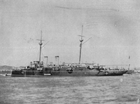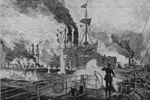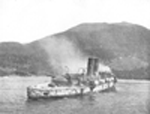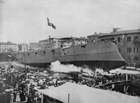Spanish Ships in the Spanish-American War
Click on an image to see the enlarged version.
Alfonso XIII  |
Alfonso XIII was a protected cruiser with a 276-member crew.
Photographic History of Spanish-American War, p. 86. |
Emperador Carlos V  |
Larger and more powerful than the Cristobal Colón, this armored cruiser was one of a few Spanish ships to escape destruction of the U.S. Navy.
Photographic History of the Spanish-American War, p. 88. |
Reina Christina  |
The Reina Christina saw action at the Battle of Manila.
Neil, p. 306. |
Marques de Ensenada  |
This light-armor protected warship/cruiser was with Admiral Montojo's fleet at Manila when it was destroyed by Admiral Dewey's squadron.
Photographic History of the Spanish-American War, p. 106. |
Havana  |
The Havana was the most recently constructed vessel in the Spanish Navy; it was previously the Carlo Alberto of Italy. This photograph was taken at Spezia just as the ship left the dock after the launching ceremony.
Photographic History of the Spanish-American War, p. 86. |
Infanta Maria Teresa  |
The Infanta Maria Teresa carried Admiral Cervera out of Santiago Harbor on July 3, 1898.
Photographic History of the Spanish-American War, p. 274. |
Navarra  |
The Navarra was a new ship built as a commerce destroyer for the Spanish Navy.
Photographic History of the Spanish-American War, p. 86. |
Nueva España  |
The Nueva España was one of a number of little gunboats to be found in the Cuban waters during the war.
Photographic History of the Spanish-American War, p. 86. |
Almirante Oquendo   |
This cruiser was part of Admiral Cervera's fleet. On Sunday July 3, 1898, off the coast of Santiago de Cuba, Admiral Sampson reported that the Almirante Oquendo was probably set on fire in the first fifteen minutes of the sea-fight with the United States.
Photographic History of Spanish-American War, p. 265 (left) and p. 269 (right). Download an uncompressed TIFF (.tif) version of the image on the left. Download an uncompressed TIFF (.tif) version of the image on the right. |
General Valdes  |
Cuban insurgents were kept guarded within walls of the ancient castle and fortress of Monjuich which was high above the city of Barcelona. This dispatch-boat was used by the Spanish Navy to protect Monjuich.
Photographic History of the Spanish-American War, p. 306. |
Varese |
The Varese, an armored cruiser from Italy, is shown moving form stocks at the Leghorn dockyard. The Spanish flag is being hoisted as she takes the water. The Varese saw no active duty during the war.
Photographic History of the Spanish-American War, p. 87. |
Vizcaya  |
The Vizcaya was believed to be one of the most effective fighting machines in the Spanish Navy. It carried two guns which hurled 500 pound solid steel conical-shaped projectiles a distance of twelve miles.
Photographic History of the Spanish-American War, p. 270. |
World of 1898 Home | Introduction | Chronology | Index | Bibliography | Literature | Maps | American Memory
 Library of Congress
Library of Congress
Comments: Ask a Librarian (
June 22, 2011
)
Legal | External Link Disclaimer